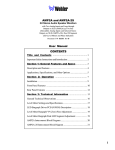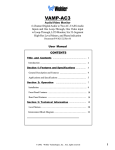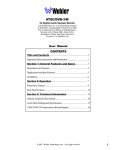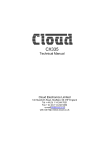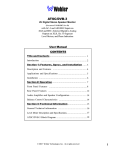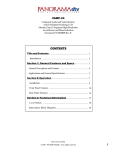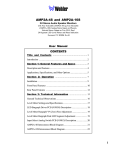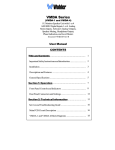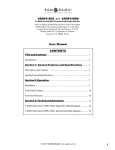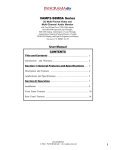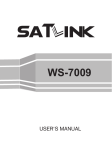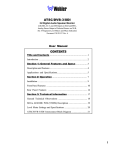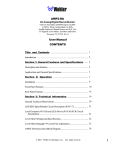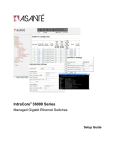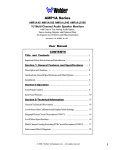Download Wohler ATSC-1 Specifications
Transcript
ATSC-1 2U Monitor Speaker Unit with 6 Analog Inputs, Selected Analog Outputs, Headphone Output, 6 Channel Monitoring, 6 Level Meters, and Phase Indication Document P/N 821509 Rev-C CONTENTS Title and Contents ............................................................... 1 Important Safety Instructions and Introduction .............................. 3 Description and Features .............................................................. 4 General Specifications .................................................................. 5 Section 1: Operation .......................................................... 7 Front Panel Controls and Indicators ............................................. 8 Rear Panel Connectors ................................................................ 12 Section 2: Tech Support ................................................. 15 Service and Troubleshooting Guide .............................................. 16 Audio Circuit Description ............................................................. 17 Phase Indication and Level Metering Description ........................... 18 Analog Input Block Diagram ......................................................... 20 Interconnect Block Diagram ......................................................... 21 Note: This manual is specifically applicable to the standard version of the ATSC-1. For information about any custom options, which are installed in the unit, please refer to the relevant separate addendum, which should be furnished with this manual. © 2006 Wohler Technologies Inc. ALL rights reserved 1 Important Safety Instructions 1) Read these instructions. 2) Keep these instructions. 3) Heed all warnings. 4) Follow all instructions. 5) Do not use this apparatus near water. 6) Clean only with dry cloth. 7) Do not block any ventilation openings. Install in accordance with the manufacturer's instructions. 8) Do not install near any heat source such as radiators, heat registers, stoves, or other apparatus (including amplifiers) that produce heat. 9) Do not defeat the safety purpose of the polarized or grounding-type plug. A polarized plug has two blades with one wider than the other. A grounding type plug has two blades and a third grounding prong. The wide blade or the third prong are provided for your safety. If the provided plug does not fit into your outlet, consult an electrician for replacement of the obsolete outlet. 10) Protect the power cord from being walked on or pinched, particularly at plugs convenience receptacles and the point where they exit from the apparatus. 11) Only use attachments/accessories specified by the manufacturer. 12) Use only with the cart stand, tripod, bracket, or table specified by the manufacturer, or sold with the apparatus. When a cart is used, use caution when moving the cart/apparatus combination to avoid injury from tip-over. 13) Unplug this apparatus during lightning storms or when unused for long periods of time. 14) Refer all servicing to qualified service personnel. Servicing is required when the apparatus has been damaged in any way, such as when power-supply cord or plug is damaged, liquid has been spilled or objects have fallen into the apparatus, the apparatus has been exposed to rain or moisture, does not operate normally, or has been dropped. 15) Do not expose this apparatus to rain or moisture. 16) The apparatus shall be connected to a mains socket outlet with a protective earthing connection. CAUTION! In products featuring an audio amplifier and speakers, the surface at the side of the unit, where the audio amplifier heat sink is internally attached, may get very hot after extended operation. When operating the unit excercise caution when touching this surface and ensure that external materials which may be adversely affected by heat are not in contact with it. There is a Hot Surface label (see diagram) attached to the aforementioned surface of the product. Introduction Congratulations on your selection of a Wohler Technologies ATSC-1 audio monitor unit. We are confident it represents the best performance and value available, and we guarantee your satisfaction with it. If you have questions or comments you may contact us at: Wohler Technologies, Inc. Wohler Technologies, Inc. 31055 Huntwood Avenue 31055 Huntwood Avenue Hayward, CA 94544 Hayward, CA 94544 Phone: (510) 870-0810 Phone: (510) 589-5676 Fax: Fax:(510) (510) 870-0811 870-0811 US Toll-Free: US Toll-Free:1-888-596-4537 1-888-596-4537 web: www.wohler.com [email protected] e-mail: [email protected] www.wohler.com 2 © 2006 Wohler Technologies Inc. ALL rights reserved INSTALLATION Mounting The unit should be mounted where convenient for operating persons, ideally at approximately ear level for best high frequency response. Its superior magnetic shielding eliminates concerns about locating it adjacent to most types of CRT monitors, including even high-resolution color monitors. Heat Dissipation Heat dissipated by the speaker amps is conducted directly to the left side of the chassis; no special considerations for cooling are necessary as long as the ambient temperature inside the rack area does not exceed approximately 40°C (104°F). Sympathetic Vibration Sympathetic vibration from other equipment (cables, etc.) in the rack may be serious enough to interfere with the unit’s sound quality out in the listening area. The use of thin card stock and/or felt or foam weather-stripping type materials between adjacent vibrating surfaces, or tying up loose cables, etc., may be required to stop vibrations external to the unit. Mechanical Bracing Even though the unit is fairly heavy, the chassis is securely attached to the front panel at eight points along its surface, not just at the four corners of the chassis ears. This feature will reduce or eliminate rear bracing requirements in many mobile/portable applications. The weight of internal components is distributed fairly evenly around the unit. Audio Connections Connection of the audio feeds is straightforward. The system block diagram located on page 24 may be referred to for clarification of the general signal paths into and out of the ATSC-1 unit. Electrical Interference As with any audio equipment, maximum immunity from electrical interference requires the use of shielded cable; however, satisfactory results can sometimes be obtained without it. The internal circuitry common is connected to the chassis. Unbalanced sources may also be applied to the balanced inputs. The gain is 6 dB greater with a single-ended source connected across both “hot” terminals than when connected between either input and common. Note that the unused input terminal of a balanced input should be connected to common, rather than being left floating, to insure best immunity to noise. AC Power The unit's AC mains connection is via a standard IEC inlet, with safety ground connected directly to the unit's chassis. The universal AC input (100-240VAC, 50/60Hz) switching power supply is a self-resetting sealed type, with automatic overvoltage and overcurrent shutdown. There is no user-replaceable fuse in either the primary or secondary circuit. © 2006 Wohler Technologies Inc. ALL rights reserved 3 713 Grandview Drive, South San Francisco,CA 94080 650 589-5676 Fax: 650 589-1355 ATSC-1 Powered Audio Monitor ATSC-1 Front Panel Description The ATSC-1 is a powered stereo monitor designed specifically for flexible, comprehensive monitoring of six analog audio channels associcated with "Surround Sound" programming. The unit is 2RU in size, for excellent fidelity without using excessive rackspace in the critical ‘operating zone’ of rack bays and consoles. The ATSC-1 input accepts six separate analog signals. These audio inputs can handles monitoring requirements throughout the facility. The speakers and amplifiers are arranged in the popular Wohler “biamp summed bass stereo” configuration: bass frequencies from ALL selected channels are summed into a 20W amplifier, which drives the woofer. The two side channel amplifiers and speakers reproduce, in stereo, only the mid- and high- frequencies. Note that the center speaker (the woofer) is NOT a dedicated Center nor LFE speaker. There is also a headphone output which mutes the speakers while in use. Six wide-range LED bargraph level meters are provided for all six channels for accurate metering. Twenty bicolor segments display signal levels according to either PPM and VU standards, as selected by the user. Both Left/Right and Front/Rear (Surround) "Phase"/Polarity LED indications are provided, to alert of possible cancellation from mixdown in any likely home playback situation. To isolate possible faults, rotary switches let the operator route any one or pair of inputs to left and right speaker channels for acoustic monitoring. Or, a toggle switch mixes all six channels down to two for listening to all channels at once. Features • 2U high: highest fidelity in minimum rackspace • Accepts Analog signals input on six XLR connectors • Left/Right and Front/Rear “phase” indicators • Select any channel or pair of channels for • Simultaneous visual monitoring all 6 channels • Six 20-segment tri-color LED isolated listening, or a stereo mixdown of all 6 channels • Headphone output bargraphs 4 © 2006 Wohler Technologies Inc. ALL rights reserved Applications The ATSC-1 is intended primarily for use in machine rooms and edit bays where on-the-spot, high-fidelity confidence monitoring of six channels is required. Thorough magnetic shielding (less than 1 Gauss at any surface) allows installation of the unit immediately adjacent to video monitors. Designed for optimum reproduction in relatively close-up use, the ATSC-1 unit has more than enough acoustic output, even for noisy transmitter sites (104 dB SPL at two feet), and a surprisingly broad and smooth useable frequency response of 40 Hz to 18 kHz. Designed, built, and rigorously tested in the U.S., the ATSC-1 monitor is backed by a strong two year warranty and a "satisfaction guaranteed" return policy. General Specifications Input meter Threshold: -6, 0, +4, or +8 dBv (DIPswitch selectable) Input Meter Dynamics: VU or PPM (DIP-switch selectable) Input Impedance: 100K Ohms balanced 22K Ohms unbalanced Peak Acoustic Output (@2 ft.): Hum and Noise: Better than -70 dB below full output. Magnetic Shielding: < 0.8 Gauss any adjacent surface. AC Mains Power Requirements: 100-250VAC, 50/60Hz universal input, auto switching. 104 dB SPL, minimum Power Consumption (avg. max.): Acoustic Response, 6th octave: 70 Hz - 16 kHz (±5 dB) (-10dB @ 40Hz, 20kHz) Speaker Amp Power output RMS each side (4 ohm): 20 W transient / 11 W cont. RMS center bass (4 ohm): 36 W transient / 20 W cont. Distortion, Electrical (@ Speaker Outputs): Distortion, Acoustic: Less than 0.1% at any level below limit threshold. 6% or less at worst case frequencies above 120 Hz, including cabinet resonance; typically less than 1.5%. Dimensions (H x W x D): Weight: 60W 3.5 x 19 x 12 inches 89 x 483 x 298 mm 18 lbs. (8.2 kg) ‘ALL’ Channel Summing Assignments*: Left Side = LFront+L.Surr+.5Center+.5LFE; Right side = R.Front+R.Surr.+.5Center+.5LFE * On special order, custom combinations of selected channels are available; either in lieu of, or in addition to, the regular selections. Typical Audio Response Curve Units are certified to meet, at time of manufacture, all currently applicable product safety and EMC requirements, such as those of UL and CE. 0 dbV ref. 0.775V RMS. Features and specifications subject to improvement without notice. © 2006 Wohler Technologies Inc. ALL rights reserved 5 (This page left intentionally blank) 6 © 2006 Wohler Technologies Inc. ALL rights reserved Section 1: Operation Front Panel Controls and Indicators Rear Panel Connectors and Settings © 2006 Wohler Technologies Inc. ALL rights reserved 7 FRONT PANEL CONTROLS AND INDICATORS Please refer to Figure 1a on the following page to familiarize yourself with the front panel controls and indicators of the ATSC-1 unit. The following sections describe the functions of each of the various controls and indicators found on the front panel. The numbers associated with each heading of the following sections refer to the item reference “balloon” and leader arrows used in the front panel illustration to point out the locations of the items described. Reference numbers (front panel) and reference letters (rear panel) are in parentheses when referred to in the main text. 1 Internal Speakers The ATSC-1 internal speaker system is comprised of two mid-range tweeter speakers (left and right) and one woofer speaker (center). The two side channel speakers reproduce, in stereo, only the mid and high frequencies. Please note that the woofer speaker (center) is not a dedicated Center nor LFE speaker. To monitor any one or pair of six possible input sources to left and right speakers use the right and left speaker select rotary switches (Items 7 and 8, page 10) or monitor a mix of all channels on both side speakers using the ALL/SELECTED channel toggle switch (Items 9, page 10). 2 Headphone Jack For critical listening or for listening in high noise environments, use the headphone feature rather than the internal speakers. Select the headphone audio sources as you would for the internal speakers. When you plug in headphones, the internal or external speakers will mute. This jack accepts the standard 1/4” phone type stereo plug. 3 Audio Level Bargraph Meter Displays Audio levels for source channels 1 - 6 are displayed via six 20-segment LED bargraph meters (three on the left side of the front panel; three on the right side). Dynamic range for these meters is 43dB and they are able to display signal levels using either PPM or VU standards as set by the user via DIP switches accessible through the top cover (see DIP swich settings in Fig-1c on page 18). Each meter is labeled on the front panel according to the standard Surround Sound nomenclature (left front, right front, center, low frequency effects, left surround, and right surround). Contact the factory for additional meter information concerning meter scales and ballistics. 4 Phase Indication LEDs (Left/Right relationship) These three LEDs offer instant verification of phase (polarity) conditions in the pair of channels selected for monitoring in the Left/Right channel relationships. There are three LEDs; the two smaller LEDs on either side show instantaneous phase relationships in the signal, while the center (and larger) LED will indicate the average phase condition. The left side, or in-phase, LED glows (or blinks) green when signals are in phase. The right side, or out-of-phase, LED glows (or blinks) amber for out of phase signals. The center LED indicates the average phase condition by glowing green for in-phase conditions, or red for out-of-phase conditions. In general, it is sufficient to regard the center LED (average phase condition) as adequete for proper phase monitoring. While it is normal for stereo signals to contain some intermittant instanateous out-of-phase and in-phase conditions (small LEDs), a steady red glow of the larger center LED almost always indicates an out-of-phase alarm condition. 5 Phase Indication LED (Front/Rear relationship) This single LED offers verification of the phase (polarity) condition as monitored in the Front/Rear channel relationships. This LED will indicate the average phase condition in these signals by glowing green for in-phase conditions, or red for out-of-phase conditions. While it is normal for stereo signals to contain some intermittant instanateous outof-phase and in-phase conditions (flickering of LED), a steady red glow of this LED almost always indicates an out-ofphase alarm condition. 8 © 2006 Wohler Technologies Inc. ALL rights reserved Figure 1a.- ATSC-1 Front Panel Controls and Indicators © 2006 Wohler Technologies Inc. ALL rights reserved 9 FRONT PANEL CONTROLS AND INDICATORS (Cont.) 6 Power Indicator LED The Power Indication LED signals the operating condition of the power supply. The LED glows green to indicate the ATSC-1 is connected to mains power and an operation voltage is present. 7 Left Speaker Select Rotary Switch This six position rotary switch allows you to isolate and monitor any one of the six possible channels through the left speaker. Simply choose positions 1 - 6 and the chosen channel will be monitored from the left speaker. Note: This function is disabled if the ALL/SELECTED toggle switch (Item 9, page 8) in in the “ALL” position. 8 Right Speaker Select Rotary Switch This six position rotary switch allows you to isolate and monitor any one of the six possible channels through the right speaker. Simply choose positions 1 - 6 and the chosen channel will be monitored from the right speaker. Note: This function is disabled if the ALL/SELECTED toggle switch (Item 9) in in the “ALL” position. 9 ALL/SELECTED Channel Monitoring Toggle Switch When this two position toggle switch in in the “ALL” position, all six channels are monitored in a stereo mixdown through both left and right speakers. When in the “SELECTED” position, channel selection defaults to the Left Speaker Select rotary switch (Item 7) and Right Speaker Select rotary switch (Item 8). 10 Speaker Selector Disabled Indicator LED When the ALL/SELECTED toggle switch (Item 9) is in the “ALL” position then the left and right speaker select switches are disabled and this LED glows red. 11 Volume Control This controls the loudness of the audio transduced by the internal speakers or connected headphone. 12 Balance Control This pans the volume balance between the left and right speakers. If the balance is adjusted hard left or right, a slight L+R channel mix is retained (only in low bass frequencies) so that phase discrepancies can be discerned. 10 © 2006 Wohler Technologies Inc. ALL rights reserved Figure 1a.- ATSC-1 Front Panel Controls and Indicators © 2006 Wohler Technologies Inc. ALL rights reserved 11 REAR PANEL CONNECTORS AND SETTINGS Please refer to Figure 1b on the following page to familiarize yourself with the rear panel features of the ATSC-1 unit. The following sections describe, in some detail, the functions of each of the various features found on the rear panel. The circled letters associated with each heading of the following section refers to the item reference “balloon” (and leader arrows) used in the rear panel illustration to point out the locations of the items described. Reference numbers (front panel) and reference letters (rear panel) are in parentheses when referred to in the main text A Power Connector Attach a standard IEC-320 power cord between this connector and mains power (100 - 250VAC, 50/60 Hz). The front panel power LED (Item 6) will glow green to indicate operating voltages are present. B Analog Inputs - L Front/R Front/Center/LF EFX/L Surr/R Surr These six inputs are meant to receive analog signals. They are panel mounted 3-pin female XLR connectors and are configured for balanced (100K Ohm). Unbalanced signals may be connected between either pin 2 or pin 3 and pin 1. In the case, a jumper must be added to connect the unused input (3 or 2) to pin 1. From left to right (as viewed from the rear of the unit) the inputs are labeled L Front, R Front, Center, LF EFX, L Surr, and R Surr in keeping with standard Surround Sound nomenclature. Although the ATSC-1 is primarily designed to monitor the six channels commonly used in Surround Sound applications, it will monitor any six analog signals the user chooses to input at these connectors. C Selected Output (Analog) - XLR Connectors These two panel mounted 3-pin male XLR connectors are analog outputs of the source as selected for the left and right speakers. The left and right XLR connectors output Channel A (left) and Channel B (right) of the six input channels, in accordance with the settings of the right and left Speaker Select rotary switches (Items 7 and 8) on the front panel. (This assumes the ALL/SELECTED toggle switch (Item 9) is set to “SELECTED”.) If the All/SELECTED Channel Monitoring toggle switch (Item 9) is set to “ALL”, then both XLR connectors output a stereo mix of all six main channels. 12 © 2006 Wohler Technologies Inc. ALL rights reserved Figure 1b.- ATSC-2 Rear Panel Connectors and Settings © 2006 Wohler Technologies Inc. ALL rights reserved 13 (This page left intentionally blank) 14 © 2006 Wohler Technologies Inc. ALL rights reserved Section 2: Technical Support Service and Toubleshooting Guide Audio Circuit Description Phase Indication Interconnect Block Diagram © 2006 Wohler Technologies Inc. ALL rights reserved 15 SERVICE AND TROUBLESHOOTING GUIDE General Mechanical Observations Elimination of cabinet and component sympathetic vibrations (resonances) requires considerable attention to mechanical details. Because of this, and the physical constraints of the speaker’s acoustic enclosures, even minor changes to any of the mechanical details of the unit can seriously impair its acoustic performance. This especially applies to the speaker baffles. If mechanical work on the unit is necessary, be sure to make adequate notes to permit accurate reassembly. Unfortunately, the unusual and wholly proprietary method of magnetic shielding is usually degraded slightly by any disassembly of the unit, except removal of the rear panel. Almost any maintenance or repair will require removal of the cover. If an immediately adjacent video monitor shows magnetic interference after reassembly of the unit, it must be returned to the factory to restore the shielding completely. Refer to the annotated block diagram and the overall unit interconnect diagram following, for assistance in tracing the signal path through the detailed schematic. General Audio Circuitry Observations Since a single-sided power supply is used, all amplifier sections are “biased” with a 1/2 supply reference, so all opamp signal terminals on the main board should have a DC level of +12V, +/-0.7V. Signal inputs to the main audio board from any of the input select circuits are via the balanced input stage, in lieu of the XLR analog inputs on the basic unit. Signal feed points for level meters and the phase indicator are immediately after the input stage, and before the volume control section. The signal pick-off for the headphones is after the volume and balance controls. Analog switches mute the speakers, controlled by circuitry, which senses connection of headphones to the jack. The power amps are attached to an aluminum heatsink plate (which is also connected to the circuit common for these devices). The heatsink plate forms an operational module separate from the chassis, which allows access to the solder side of the circuit board while power is applied to the circuitry. To avoid thermal shutdown of the power amp(s), they should NOT be operated without their tabs being fastened to the heatsink plate. Variations in the frequency response of different production runs of drivers has sometimes required minor adjustments in the equalization/crossover components in individual runs of units. Some of these components may have values slightly different than those indicated in the schematic, which are the nominal ones. If any of the drivers (speakers) are replaced, it may be helpful to change some of these components to achieve maximum flatness of response. The operating threshold of the woofer limiter is critical to both satisfactory reproduction of musical transients and preventing damage to, or destruction of, the speaker itself. The side speaker output limiter circuits are similarly important, though not as critically adjusted. The woofer power amps are arranged in a bridge configuration; care must be taken to avoid letting EITHER speaker terminal contact the chassis (common) OR THE GROUNDED LEAD OF ANY TEST EQUIPMENT so as not to short out the power amps. The side speaker outputs are single-ended, so these precautions are not necessary for them. 16 © 2006 Wohler Technologies Inc. ALL rights reserved AUDIO CIRCUIT DESCRIPTION Input Section (Audio) The balanced input is buffered by a somewhat unconventional cascade differential input stage of Sections A and B of IC1 (left ch.) and IC2 (right ch.). H1 provides a point where alternative signals from certain options may be input, and buffered output from the primary input of IC1 and IC2 are available. Volume Controls Unlike our earlier circuits, volume controls for the ATSC series units are implemented with VCAs. The primary advantages of this method are a reduction in possible signal degradation from having to physically route the audio signals through the volume/balance controls. This is especially true for the inevitable wiper contact degradation in the pot itself, which no longer results in scratchy noise in the audio. Quad VCA, Sections A and B, effect either volume-balance or A volume-B volume control functions, depending on which headers the pots are plugged into, and the setting of jumpers on JP3. An increasing voltage above a DC refence level on the control terminal of each VCA section increases attenuation of that section. For volume-balance operation, the volume control pot for both channels is connected to H3. Its wiper voltage is applied directly to the control terminal for channel B, and via a jumper on JP3 to channel A’s VCA. The balance control is connected to VCA, Sections C and D, which are also used for overall limiters for the side speakers. In a unit configured for A volume - B volume operation, pins 1 and 2 of JP3 are disconnected so that the “primary vc” pot is connected only to VCA, Section B. The other pot is connected to H4 instead of H5, so it will directly control VCA, Section A. By disconnecting pins 3 and 4 of JP3, the balance control circuitry is configured for minimum quiescent attenuation in VCA, Sections C and D. Headphone Output While headphones are not plugged in, the output terminals are open circuit and the op amp DC bias supplied by R70 and R71 keeps pins 2 and 3 of H9 high. Plugging headphones in provides a shunt path to ground for this DC through the headphones, which turns off transistor Q11. This sets pins 9, 10, and 11 on analog switch IC16 high, which switches the signals that normally go to the speaker amps to AC ground (bias) instead. The RC networks of C49 and C50 / R74 through R76 filter any highlevel low frequency transients which might otherwise affect Q11. Note that for this sensing circuit to work, the headphones MUST have a DC resistance not greater than about 1K ohm. Equalization and Side Speaker Outputs Most of the unit's overall equalization occurs at IC8 and IC9. For the side speakers, there is an additional upper HF shelf boost from the peaking network just after the input stage at IC8. There is a small amount bass summing at R101 and R102, which is directly after the main EQ stage. The side speaker amplifiers are conventional IC power amps. Low Frequency Section The low frequencies are summed at IC11; the output is on pin 1. R80 and R81 (on pin sockets) adjust the bass output level, but this also adjusts the bass limiter threshold relative to the unit's input, and therefore, also the amount of bass limiting. R82 and C53 set this stage's low pass filter rolloff point, the first of several low pass filters. The low frequency (LF) section has it own limiter circuit controlled by a Vactec type opto- isolator. The LF signal is applied to the base of Q13 for positive excursions, Q14 for negative. At low signal levels, there is not enough output from the transistors to turn the LED in the Vactec on. When the signal is great enough at the bases of the transistors, they supply current to the LED. This decreases the resistance of the Vactec's photocell, increasing the attenuation of signal at IC17b. IC20b provides additional HF rolloff for the active crossover function. The bass level after the limiter stage is set by R115 (on pin sockets). Power amps IC19 and IC21 are arranged in a differential input push-pull output. NOTE: There are NO coupling capacitors on the power amp outputs; care must be used to avoid shorting EITHER speaker terminal to chassis, so that destructive DC currents are not accidentally passed through the woofer! © 2006 Wohler Technologies Inc. ALL rights reserved 17 PHASE INDICATION DESCRIPTION Wohler Technologies developed its well known Instantaneous Phase Indicator (IPI) to enable operators to see not only whether or not a source is “in phase”, but also whether the source is stereo or mono. In the original version (four LEDs in a “diamond” pattern), the green (upper) LED showed the source’s in-phase excursions, while the red (lower) LED showed out-of-phase ones. Two amber/red bi-color LEDs on either side of the green and red LEDs showed whether a signal was present (amber) and/or overrange (red) in the respective channel. These were thought necessary because NEITHER the green nor red LED would light if signal was missing in either channel. The revised version of the phase indicator retains the instantaneous type display which is so useful for verifying stereo-mono status, but adds an average “Go-No go” indication of longer-term phase/polarity condition. For assessing the polarity status of the Left/Right channels in the ATSC-1, a bi-color (red/green) T1-3/4 size LED displays the Average, while smaller (T1 size) green and amber LEDs show the instantaneous condition. The Front/Rear channel phase relationship is monitored by a separate single bi-color (red/green) T1-3/4 size LED displaying only the Average phase condition (without the two smaller instantaneous phase LEDs). Wohler Technologies’ Website (http://www.wohler.com/ipi.htm) has animated simulations of both types of phase indicator displays (older 4-LED diamond & newer 3-LED type) as they appear with various types of input signals. It should be noted that both the original and the new circuits make their “phase” (polarity) determinations on individual excursions of the input signals. The average indication on the new type is derived by integrating the instantaneous determinations. Due to the highly proprietary nature of this circuit, detailed information is not available. This circuit is, however, very reliable, and is warranted against defects for an additional year (three years compared to the usual two years for standard Wohler products.) LEVEL METERING DESCRIPTION Input Stage and Level Gain Calibration The “PPM-2” display driver circuit provides a total of 43dB (+ peak) of visual audio level indication via a 20-segment LED bargraph. The main PCB's input buffer amps pass unbalanced signals through a DIP switch selectable attenuator pad on each 919030 meter driver PCB. A choice of four different reference (gain) calibration levels, -6, 0, +4, and +8 dB for the 0dB indication is available. See Fig-1c (below) for a chart showing these DIP switch settings. A chart can also be found on a label on the top cover of the ATSC-1. Each of the differential outputs from the meter driver's input buffer drives a half-wave rectifier circuit; IC6a for positive input excursions and 5b for negative ones. The outputs from the rectifier stages are combined and presented to two different filter circuits that generate both PPM (IC3B) and VU (IC4) characteristic signals. Figure 1c.- Gain and Ballistics DIP Switch Settings for Meter Driver (919030) (Continued) 18 © 2006 Wohler Technologies Inc. ALL rights reserved LEVEL METERING DESCRIPTION (Cont.) Meter Ballistics When S4 is open and S3 closed, the PPM signal drives the display circuitry. This signal is created by IC4B and associated circuitry. A positive signal from the rectifiers causes the opamp output to go high turning on Q1. This charges C10 through a reverse protection diode (D2) and a resistor (R18). When the signal level decreases, Q3 turns off and C10 discharges through R15 and R9. Closing S4 and opening S3 allows the VU signal to drive the bargraph drivers. This signal is generated by IC3a and associated components configured as an active filter to provide the proper VU characteristic. See Fig-1c (page 21) for a chart showing the ballistics DIP switch settings. A chart can also be found on a label on the top cover of the ATSC1. Bargraph Driver The signal (PPM or VU) directly drives the LM3916, which drives the upper bargraph display. IC4a provides an additional 16dB of gain to the lower bargraph display driver (LM3915). D1 provides the reference supply to all opamps and both LM391x display drivers. The LED drive current (brightness) is about 10x the current taken from pin 7. Pins 6 and 4 are the top and bottom connections to the reference dividers inside the display drivers. The voltage across R1, P1, R2, and DP1 is the reference against which the rectifier output applied to pin 5 is compared. The meter zero level is calibrated by adjusting P1. Refer to National Semiconductor Linear data books or website for a detailed discussion of the LM3915 and 3916 bargraph display drivers. NOTE: The driver PCB connects the LEDs in each bargraph in two SERIES strings (one for the upper, and another for the lower). The anode of the LED corresponding to the LOWEST input level in each string (-10 or -40) is connected to V+, with the other 9 LEDs (8 in the upper one) following. The outputs of the 3915/16 are connected to the node between each LED. Only ONE output of the 3915/16 is active (LOW) at any one time (“dot” mode), so if the LED string is “broken” (open) at any point, the bargraph in that half of the display (only) will go OFF whenever the input level is AT OR ABOVE the level corresponding to the break! IC5A is configured as a comparator, nominally set at 6dB above “0” to drive the topmost segment of the upper bargraph display as a peak indicator. The peak segment's threshold is set by P2. © 2006 Wohler Technologies Inc. ALL rights reserved 19 ATSC-1 Analog Input Block Diagram 20 © 2006 Wohler Technologies Inc. ALL rights reserved ATSC-1 System Interconnect Block Diagram © 2006 Wohler Technologies Inc. ALL rights reserved 21 Wohler Technologies, You can now contact usInc. at: 31055 Huntwood Avenue Hayward, CA 94544 Wohler Technologies, Phone: (510) 589-5676 Inc. 31055 Avenue Fax:Huntwood (510) 870-0811 Hayward, CA 94544 US Toll-Free: 1-888-596-4537 Phone: (510) 870-0810 web: www.wohler.com (510) 870-0811 e-mail:Fax: [email protected] US Toll-Free: 1-888-596-4537 www.wohler.com [email protected] 22 © 2006 Wohler Technologies Inc. ALL rights reserved























